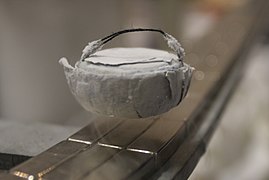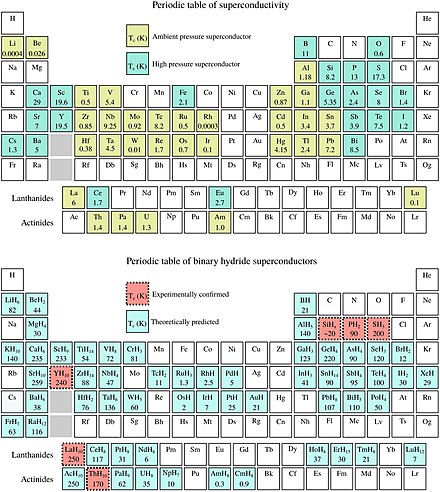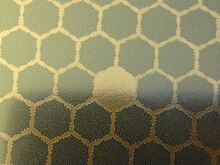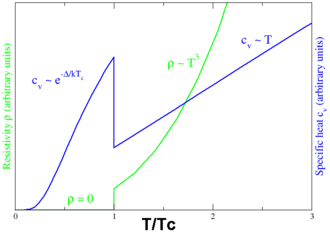Superconductivity

| Articles about |
| Electromagnetism |
|---|
 |
Superconductivity is a set of physical properties observed in certain materials where electrical resistance vanishes and magnetic fields are expelled from the material. Any material exhibiting these properties is a superconductor. Unlike an ordinary metallic conductor, whose resistance decreases gradually as its temperature is lowered, even down to near absolute zero, a superconductor has a characteristic critical temperature below which the resistance drops abruptly to zero.[1][2] An electric current through a loop of superconducting wire can persist indefinitely with no power source.[3][4][5][6]
The superconductivity phenomenon was discovered in 1911 by Dutch physicist
In 1986, it was discovered that some
Classification
There are many criteria by which superconductors are classified. The most common are:
Response to a magnetic field
A superconductor can be
By theory of operation
It is
By critical temperature
A superconductor is generally considered high-temperature if it reaches a superconducting state above a temperature of 30 K (−243.15 °C);[12] as in the initial discovery by Georg Bednorz and K. Alex Müller.[7] It may also reference materials that transition to superconductivity when cooled using liquid nitrogen – that is, at only Tc > 77 K, although this is generally used only to emphasize that liquid nitrogen coolant is sufficient. Low temperature superconductors refer to materials with a critical temperature below 30 K, and are cooled mainly by liquid helium (Tc > 4.2 K). One exception to this rule is the iron pnictide group of superconductors which display behaviour and properties typical of high-temperature superconductors, yet some of the group have critical temperatures below 30 K.
By material

Bottom: Periodic table of superconducting binary hydrides (0–300 GPa). Theoretical predictions indicated in blue and experimental results in red[13]
Superconductor material classes include
Elementary properties of superconductors
This section needs additional citations for verification. (April 2018) |
Several physical properties of superconductors vary from material to material, such as the critical temperature, the value of the superconducting gap, the critical magnetic field, and the critical current density at which superconductivity is destroyed. On the other hand, there is a class of properties that are independent of the underlying material. The Meissner effect, the quantization of the magnetic flux or permanent currents, i.e. the state of zero resistance are the most important examples. The existence of these "universal" properties is rooted in the nature of the broken symmetry of the superconductor and the emergence of off-diagonal long range order. Superconductivity is a thermodynamic phase, and thus possesses certain distinguishing properties which are largely independent of microscopic details. Off diagonal long range order is closely connected to the formation of Cooper pairs.
Zero electrical DC resistance

The simplest method to measure the
Superconductors are also able to maintain a current with no applied voltage whatsoever, a property exploited in superconducting electromagnets such as those found in MRI machines. Experiments have demonstrated that currents in superconducting coils can persist for years without any measurable degradation. Experimental evidence points to a lifetime of at least 100,000 years. Theoretical estimates for the lifetime of a persistent current can exceed the estimated lifetime of the universe, depending on the wire geometry and the temperature.[5] In practice, currents injected in superconducting coils have persisted for more than 27 years (as of August 2022) in superconducting gravimeters.[16][17] In such instruments, the measurement is based on the monitoring of the levitation of a superconducting niobium sphere with a mass of 4 grams.
In a normal conductor, an electric current may be visualized as a fluid of electrons moving across a heavy ionic lattice. The electrons are constantly colliding with the ions in the lattice, and during each collision some of the energy carried by the current is absorbed by the lattice and converted into heat, which is essentially the vibrational kinetic energy of the lattice ions. As a result, the energy carried by the current is constantly being dissipated. This is the phenomenon of electrical resistance and Joule heating.
The situation is different in a superconductor. In a conventional superconductor, the electronic fluid cannot be resolved into individual electrons. Instead, it consists of bound pairs of electrons known as
In the class of superconductors known as
Phase transition

In superconducting materials, the characteristics of superconductivity appear when the temperature T is lowered below a critical temperature Tc. The value of this critical temperature varies from material to material. Conventional superconductors usually have critical temperatures ranging from around 20
Similarly, at a fixed temperature below the critical temperature, superconducting materials cease to superconduct when an external magnetic field is applied which is greater than the critical magnetic field. This is because the Gibbs free energy of the superconducting phase increases quadratically with the magnetic field while the free energy of the normal phase is roughly independent of the magnetic field. If the material superconducts in the absence of a field, then the superconducting phase free energy is lower than that of the normal phase and so for some finite value of the magnetic field (proportional to the square root of the difference of the free energies at zero magnetic field) the two free energies will be equal and a phase transition to the normal phase will occur. More generally, a higher temperature and a stronger magnetic field lead to a smaller fraction of electrons that are superconducting and consequently to a longer London penetration depth of external magnetic fields and currents. The penetration depth becomes infinite at the phase transition.
The onset of superconductivity is accompanied by abrupt changes in various physical properties, which is the hallmark of a phase transition. For example, the electronic heat capacity is proportional to the temperature in the normal (non-superconducting) regime. At the superconducting transition, it suffers a discontinuous jump and thereafter ceases to be linear. At low temperatures, it varies instead as e−α/T for some constant, α. This exponential behavior is one of the pieces of evidence for the existence of the energy gap.
The
Calculations in the 1970s suggested that it may actually be weakly first-order due to the effect of long-range fluctuations in the electromagnetic field. In the 1980s it was shown theoretically with the help of a
Meissner effect
When a superconductor is placed in a weak external magnetic field H, and cooled below its transition temperature, the magnetic field is ejected. The Meissner effect does not cause the field to be completely ejected but instead, the field penetrates the superconductor but only to a very small distance, characterized by a parameter λ, called the London penetration depth, decaying exponentially to zero within the bulk of the material. The Meissner effect is a defining characteristic of superconductivity. For most superconductors, the London penetration depth is on the order of 100 nm.
The Meissner effect is sometimes confused with the kind of diamagnetism one would expect in a perfect electrical conductor: according to Lenz's law, when a changing magnetic field is applied to a conductor, it will induce an electric current in the conductor that creates an opposing magnetic field. In a perfect conductor, an arbitrarily large current can be induced, and the resulting magnetic field exactly cancels the applied field.
The Meissner effect is distinct from this – it is the spontaneous expulsion that occurs during transition to superconductivity. Suppose we have a material in its normal state, containing a constant internal magnetic field. When the material is cooled below the critical temperature, we would observe the abrupt expulsion of the internal magnetic field, which we would not expect based on Lenz's law.
The Meissner effect was given a phenomenological explanation by the brothers Fritz and Heinz London, who showed that the electromagnetic free energy in a superconductor is minimized provided
where H is the magnetic field and λ is the London penetration depth.
This equation, which is known as the
A superconductor with little or no magnetic field within it is said to be in the Meissner state. The Meissner state breaks down when the applied magnetic field is too large. Superconductors can be divided into two classes according to how this breakdown occurs. In Type I superconductors, superconductivity is abruptly destroyed when the strength of the applied field rises above a critical value Hc. Depending on the geometry of the sample, one may obtain an intermediate state[24] consisting of a baroque pattern[25] of regions of normal material carrying a magnetic field mixed with regions of superconducting material containing no field. In Type II superconductors, raising the applied field past a critical value Hc1 leads to a mixed state (also known as the vortex state) in which an increasing amount of magnetic flux penetrates the material, but there remains no resistance to the flow of electric current as long as the current is not too large. At a second critical field strength Hc2, superconductivity is destroyed. The mixed state is actually caused by vortices in the electronic superfluid, sometimes called fluxons because the flux carried by these vortices is quantized. Most pure elemental superconductors, except niobium and carbon nanotubes, are Type I, while almost all impure and compound superconductors are Type II.
London moment
Conversely, a spinning superconductor generates a magnetic field, precisely aligned with the spin axis. The effect, the London moment, was put to good use in Gravity Probe B. This experiment measured the magnetic fields of four superconducting gyroscopes to determine their spin axes. This was critical to the experiment since it is one of the few ways to accurately determine the spin axis of an otherwise featureless sphere.
History

Superconductivity was discovered on April 8, 1911, by Heike Kamerlingh Onnes, who was studying the resistance of solid mercury at
Great efforts have been devoted to finding out how and why superconductivity works; the important step occurred in 1933, when Meissner and Ochsenfeld discovered that superconductors expelled applied magnetic fields, a phenomenon which has come to be known as the Meissner effect.[29] In 1935, Fritz and Heinz London showed that the Meissner effect was a consequence of the minimization of the electromagnetic free energy carried by superconducting current.[30]
London constitutive equations
The theoretical model that was first conceived for superconductivity was completely classical: it is summarized by London constitutive equations. It was put forward by the brothers Fritz and Heinz London in 1935, shortly after the discovery that magnetic fields are expelled from superconductors. A major triumph of the equations of this theory is their ability to explain the Meissner effect,[29] wherein a material exponentially expels all internal magnetic fields as it crosses the superconducting threshold. By using the London equation, one can obtain the dependence of the magnetic field inside the superconductor on the distance to the surface.[31]
The two constitutive equations for a superconductor by London are:
Conventional theories (1950s)
During the 1950s, theoretical condensed matter physicists arrived at an understanding of "conventional" superconductivity, through a pair of remarkable and important theories: the phenomenological Ginzburg–Landau theory (1950) and the microscopic BCS theory (1957).[32][33]
In 1950, the
Also in 1950, Maxwell and Reynolds et al. found that the critical temperature of a superconductor depends on the isotopic mass of the constituent element.[35][36] This important discovery pointed to the electron-phonon interaction as the microscopic mechanism responsible for superconductivity.
The complete microscopic theory of superconductivity was finally proposed in 1957 by
The BCS theory was set on a firmer footing in 1958, when
Generalizations of BCS theory for conventional superconductors form the basis for the understanding of the phenomenon of superfluidity, because they fall into the lambda transition universality class. The extent to which such generalizations can be applied to unconventional superconductors is still controversial.
Further history
The first practical application of superconductivity was developed in 1954 with Dudley Allen Buck's invention of the cryotron.[40] Two superconductors with greatly different values of the critical magnetic field are combined to produce a fast, simple switch for computer elements.
Soon after discovering superconductivity in 1911, Kamerlingh Onnes attempted to make an electromagnet with superconducting windings but found that relatively low magnetic fields destroyed superconductivity in the materials he investigated. Much later, in 1955, G. B. Yntema[41] succeeded in constructing a small 0.7-tesla iron-core electromagnet with superconducting niobium wire windings. Then, in 1961, J. E. Kunzler, E. Buehler, F. S. L. Hsu, and J. H. Wernick[42] made the startling discovery that, at 4.2 kelvin, niobium–tin, a compound consisting of three parts niobium and one part tin, was capable of supporting a current density of more than 100,000 amperes per square centimeter in a magnetic field of 8.8 tesla. Despite being brittle and difficult to fabricate, niobium–tin has since proved extremely useful in supermagnets generating magnetic fields as high as 20 tesla. In 1962, T. G. Berlincourt and R. R. Hake[43][44] discovered that more ductile alloys of niobium and titanium are suitable for applications up to 10 tesla. Promptly thereafter, commercial production of niobium–titanium supermagnet wire commenced at Westinghouse Electric Corporation and at Wah Chang Corporation. Although niobium–titanium boasts less-impressive superconducting properties than those of niobium–tin, niobium–titanium has, nevertheless, become the most widely used "workhorse" supermagnet material, in large measure a consequence of its very high ductility and ease of fabrication. However, both niobium–tin and niobium–titanium find wide application in MRI medical imagers, bending and focusing magnets for enormous high-energy-particle accelerators, and a host of other applications. Conectus, a European superconductivity consortium, estimated that in 2014, global economic activity for which superconductivity was indispensable amounted to about five billion euros, with MRI systems accounting for about 80% of that total.
In 1962,
In 2008, it was proposed that the same mechanism that produces superconductivity could produce a
High-temperature superconductivity
Until 1986, physicists had believed that BCS theory forbade superconductivity at temperatures above about 30 K. In that year,
This temperature jump is of particular engineering significance, since it allows liquid nitrogen as a refrigerant, replacing liquid helium.[50] Liquid nitrogen can be produced relatively cheaply, even on-site. The higher temperatures additionally help to avoid some of the problems that arise at liquid helium temperatures, such as the formation of plugs of frozen air that can block cryogenic lines and cause unanticipated and potentially hazardous pressure buildup.[51][52]
Many other cuprate superconductors have since been discovered, and the theory of superconductivity in these materials is one of the major outstanding challenges of theoretical
]In 2008, holographic superconductivity, which uses holographic duality or AdS/CFT correspondence theory, was proposed by Gubser, Hartnoll, Herzog, and Horowitz, as a possible explanation of high-temperature superconductivity in certain materials.[58]
From about 1993, the highest-temperature superconductor known was a ceramic material consisting of mercury, barium, calcium, copper and oxygen (HgBa2Ca2Cu3O8+δ) with Tc = 133–138 K.[59][60]
In February 2008, an iron-based family of high-temperature superconductors was discovered.[61][62] Hideo Hosono, of the Tokyo Institute of Technology, and colleagues found lanthanum oxygen fluorine iron arsenide (LaO1−xFxFeAs), an oxypnictide that superconducts below 26 K. Replacing the lanthanum in LaO1−xFxFeAs with samarium leads to superconductors that work at 55 K.[63]
In 2014 and 2015,
10) becomes a superconductor at 250 K under a pressure of 170 gigapascals.[67][66]
In 2018, a research team from the Department of Physics, Massachusetts Institute of Technology, discovered superconductivity in bilayer graphene with one layer twisted at an angle of approximately 1.1 degrees with cooling and applying a small electric charge. Even if the experiments were not carried out in a high-temperature environment, the results are correlated less to classical but high temperature superconductors, given that no foreign atoms need to be introduced.[68] The superconductivity effect came about as a result of electrons twisted into a vortex between the graphene layers, called "skyrmions". These act as a single particle and can pair up across the graphene's layers, leading to the basic conditions required for superconductivity.[69]
In 2020, a room-temperature superconductor (critical temperature 288 K) made from hydrogen, carbon and sulfur under pressures of around 270 gigapascals was described in a paper in Nature.[70][71] However, in 2022 the article was retracted by the editors because the validity of background subtraction procedures had been called into question. All nine authors maintain that the raw data strongly support the main claims of the paper.[72]
On 31 December 2023 "Global Room-Temperature Superconductivity in Graphite" was published in the journal "Advanced Quantum Technologies" claiming to demonstrate superconductivity at room temperature and ambient pressure in Highly oriented pyrolytic graphite with dense arrays of nearly parallel line defects.[73]
Applications
Superconductors are promising candidate materials for devising fundamental circuit elements of electronic, spintronic, and quantum technologies. One such example is a superconducting diode,[74] in which supercurrent flows along one direction only, that promise dissipationless superconducting and semiconducting-superconducting hybrid technologies.
In the 1950s and 1960s, superconductors were used to build experimental digital computers using
Superconductors are used to build
Other early markets are arising where the relative efficiency, size and weight advantages of devices based on high-temperature superconductivity outweigh the additional costs involved. For example, in wind turbines the lower weight and volume of superconducting generators could lead to savings in construction and tower costs, offsetting the higher costs for the generator and lowering the total levelized cost of electricity (LCOE).[79]
Promising future applications include high-performance
Nobel Prizes
As of 2022, there have been five Nobel Prizes in Physics for superconductivity related subjects:
- Heike Kamerlingh Onnes (1913), "for his investigations on the properties of matter at low temperatures which led, inter alia, to the production of liquid helium".
- J. Robert Schrieffer(1972), "for their jointly developed theory of superconductivity, usually called the BCS-theory".
- Brian D. Josephson(1973), "for their experimental discoveries regarding tunneling phenomena in semiconductors and superconductors, respectively" and "for his theoretical predictions of the properties of a supercurrent through a tunnel barrier, in particular those phenomena which are generally known as the Josephson effects".
- Georg Bednorz and K. Alex Müller (1987), "for their important break-through in the discovery of superconductivity in ceramic materials".
- Anthony J. Leggett (2003), "for pioneering contributions to the theory of superconductors and superfluids".[83]
See also
References
- ISBN 9781108428415.
- ISBN 9780470026434.
- ISBN 0677000804, p. 73.
- ISBN 978-1-4381-0949-7.
- ^ ISBN 978-0-7503-0051-3.
- ISBN 978-0-7503-0721-5.
- ^ S2CID 118314311.
- ^ "Superconductivity | CERN". home.cern. Retrieved 2020-10-29.
- ^ Orthacker, Angelina. "Superconductivity" (PDF). Technical University of Graz.
- ^ "Type-1.5 superconductor shows its stripes". Physics World. 2009-02-17. Retrieved 2020-10-29.
- PMID 29517044.
Superconductors come broadly in two types: conventional, in which the activity can be explained by the mainstream theory of superconductivity, and unconventional, where it can't.
- S2CID 27665903.
- S2CID 155100283.
- S2CID 12895850.
- ^ "Classification of Superconductors" (PDF). CERN.
- .
- S2CID 134876430.
- ISBN 0486435032.
- S2CID 4468914.
- ISBN 0486435032.
- .
- S2CID 121012850.
- S2CID 13672575.
- ISBN 978-0-7506-2634-7.
- .
- ISSN 0031-9228.
- Bibcode:1910KNAB...13.1274K.
- .
- ^ S2CID 37842752.
- JSTOR 96265.
- ^ "The London equations". The Open University. Retrieved 2011-10-16.[permanent dead link]
- .
- ^ .
- Zhurnal Eksperimental'noi i Teoreticheskoi Fiziki. 20: 1064.
- .
- .
- Zhurnal Eksperimental'noi i Teoreticheskoi Fiziki. 34: 58.
- Zhurnal Eksperimental'noi i Teoreticheskoi Fiziki. 36: 1364.
- S2CID 119121639.
- ^ Buck, Dudley A. "The Cryotron – A Superconductive Computer Component" (PDF). Lincoln Laboratory, Massachusetts Institute of Technology. Retrieved 10 August 2014.
- .
- .
- ^ Berlincourt, T. G. & Hake, R. R. (1962). "Pulsed-Magnetic-Field Studies of Superconducting Transition Metal Alloys at High and Low Current Densities". Bulletin of the American Physical Society. II-7: 408.
- .
- .
- ^ "The Nobel Prize in Physics 1973". NobelPrize.org. Archived from the original on Mar 25, 2021. Retrieved 2021-03-30.
- ^ "Newly discovered fundamental state of matter, a superinsulator, has been created". Science Daily. April 9, 2008. Retrieved 2008-10-23.
- ^ "Researchers demonstrate a superconductor previously thought impossible". phys.org. Retrieved 8 December 2020.
- PMID 33158862.
- ^ PMID 10035069.
- ^ "Introduction to Liquid Helium". Cryogenics and Fluid Branch. Goddard Space Flight Center, NASA.
- ^ "Section 4.1 'Air plug in the fill line'". Superconducting Rock Magnetometer Cryogenic System Manual. 2G Enterprises. Archived from the original on May 6, 2009. Retrieved 9 October 2012.
- ^ Abrikosov, Alexei A. (8 December 2003). "type II Superconductors and the Vortex Lattice". Nobel Lecture.
- ^ Gingras, Olivier (Sep 2021). La supraconductivité non-conventionnelle du ruthénate de strontium: corrélations électroniques et couplage spin-orbite (in French). PhD thesis.
- S2CID 205066154.
- ISBN 978-0-306-45934-4
- PMID 10044736.
- ^ Jan Zaanen, Yan Liu, Ya Sun K.Schalm (2015). Holographic Duality in Condensed Matter Physics. Cambridge University Press, Cambridge.
- S2CID 4328716.
- .
- S2CID 498756.
- ^ Cho, Adrian (2014-10-30). "Second Family of High-Temperature Superconductors Discovered". ScienceNOW Daily News.
- S2CID 96240327.
- S2CID 15633660.
- S2CID 4468914.
- ^ a b Wood, Charlie (14 October 2020). "Room-Temperature Superconductivity Achieved for the First Time". Quanta Magazine. Retrieved 2020-10-29.
- S2CID 119231000.
- S2CID 4601086.
- ^ Wood, Charlie (16 March 2021). "A New Twist Reveals Superconductivity's Secrets". Quanta Magazine. Retrieved 2021-03-23.
- S2CID 222823227.
- ^ Chang, Kenneth (October 14, 2020). "Finally, the First Room-Temperature Superconductor". The New York Times.
- S2CID 252544156.
- .
- S2CID 261976918.
- ^ Design and in-field testing of the world's first ReBCO rotor for a 3.6 MW wind generator" by Anne Bergen, Rasmus Andersen, Markus Bauer, Hermann Boy, Marcel ter Brake, Patrick Brutsaert, Carsten Bührer, Marc Dhallé, Jesper Hansen and Herman ten Kate, 25 October 2019, Superconductor Science and Technology.
- ^ Brock, David C. (2014-03-19). "Dudley Buck's Forgotten Cryotron Computer". Institute of Electrical and Electronics Engineers. Retrieved 2021-03-30.
- S2CID 247422273.
- S2CID 4893642– via IOP Publishing.
- hdl:10453/33256.
- S2CID 31028550.
- .
- S2CID 46117301.
- ^ "All Nobel Prizes in Physics". Nobelprize.org. Nobel Media AB 2014.
Further reading
- The Schrödinger Equation in a Classical Context: A Seminar on Superconductivity – The Feynman Lectures on Physics.
- IEC standard 60050-815:2000, International Electrotechnical Vocabulary (IEV) – Part 815: Superconductivity.
- Kleinert, Hagen (1989). "Superflow and Vortex Lines". Gauge Fields in Condensed Matter. Vol. 1. World Scientific. ISBN 978-9971-5-0210-2.
- Larkin, Anatoly; Varlamov, Andrei (2005). Theory of Fluctuations in Superconductors. Oxford University Press. ISBN 978-0-19-852815-9.
- Lebed, A. G. (2008). The Physics of Organic Superconductors and Conductors. Vol. 110 (1st ed.). Springer. ISBN 978-3-540-76667-4.
- Matricon, Jean; Waysand, Georges; Glashausser, Charles (2003). The Cold Wars: A History of Superconductivity. Rutgers University Press. ISBN 978-0-8135-3295-0.
- "Physicist Discovers Exotic Superconductivity". ScienceDaily. 17 August 2006.
- Tinkham, Michael (2004). Introduction to Superconductivity (2nd ed.). Dover Books. ISBN 978-0-486-43503-9.
- Tipler, Paul; Llewellyn, Ralph (2002). Modern Physics (4th ed.). W. H. Freeman. ISBN 978-0-7167-4345-3.
- O'Mahony, Shane M.; University of Oxford (2022). "On the electron pairing mechanism of copper-oxide high temperature superconductivity". PMID 36067325.
- Charlie Wood, Quanta Magazine (2022). "High-Temperature Superconductivity Understood at Last".
External links
- Video about Type I Superconductors: R=0/transition temperatures/ B is a state variable/ Meissner effect/ Energy gap(Giaever)/ BCS model
- Lectures on Superconductivity (series of videos, including interviews with leading experts)
- YouTube Video Levitating magnet
- DoITPoMS Teaching and Learning Package – "Superconductivity"





